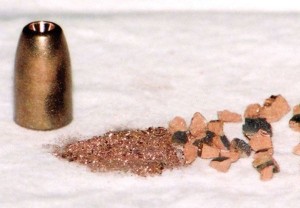A frangible bullet is one that is designed to break into pieces or to disintegrate after coming into contact with a surface harder than it. There are a few cases and applications in which this frangible nature of the round is preferred to a bullet which stays intact upon impact. In particular, frangible ammunition is considered an ideal choice for indoor range shooters and for military and law enforcement training applications because it eliminates the health concerns of lead exposure, while also removing any concern for ricochet risk.
 One of the best uses of frangible ammunition technology is in the military where it is used for training purposes. A good number of military departments are now making use of these bullets because of their ability to fragment upon impact. There are numerous advantages that are associated with this unique attribute. First of all, it makes the bullets safer to use during training. During military training sessions accidents such as ricochet may occur on a number of occasions in such cases when standard lead bullets are used. To avoid such issues, a frangible bullet may be used in the place of a standardlead bullet. On the other hand, military training exercises are aimed at the simulation real combat as much as possible. However, they still have to do so in a safe way. This safe way of mimicking real combat without endangering the lives of the trainees is possible because of the nature of the frangible bullet.
One of the best uses of frangible ammunition technology is in the military where it is used for training purposes. A good number of military departments are now making use of these bullets because of their ability to fragment upon impact. There are numerous advantages that are associated with this unique attribute. First of all, it makes the bullets safer to use during training. During military training sessions accidents such as ricochet may occur on a number of occasions in such cases when standard lead bullets are used. To avoid such issues, a frangible bullet may be used in the place of a standardlead bullet. On the other hand, military training exercises are aimed at the simulation real combat as much as possible. However, they still have to do so in a safe way. This safe way of mimicking real combat without endangering the lives of the trainees is possible because of the nature of the frangible bullet.
Another advantage of frangible bullets over standard lead bullets is that their frangible counterparts do not contain any lead. This attribute makes them safe to use during military training sessions or any other related training session that requires the use of live ammunition. This distinction is particularly important for inside ranges in which the exposure of lead particulates in the air can present a serious health risk for shooters and in particular employees of the range. When it comes to performance, many of today’s top-performing frangible ammunition can match the ballistic performance of standard lead rounds up to several hundred meters.
Generally speaking, there are two distinct types of frangible ammunition on the marketplace today. One type is made of a composite metal, such as tin and copper, which are produced using a press and sinter powder metallurgical process. The other major type of frangible bullets are made from plastic composites, standard plastics combined with metal powders to increase the material density in order to achieve the necessary ballistic performance. Such thermoplastic projectiles are produced via an injection molding process.
As the regulations against the use and disposal of lead are expected to further tighten, the expectation is that the frangible ammunition marketplace will grow significantly in order to satisfy growing demand for lead free ammunition.







0 comments:
Post a Comment